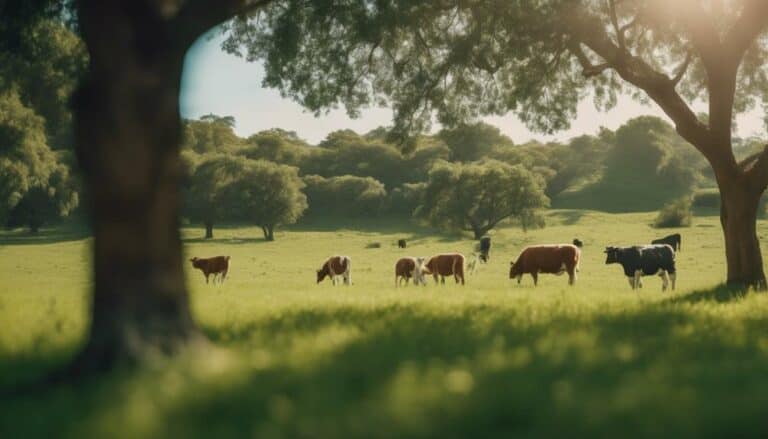Did you know that incorporating trees into livestock grazing areas can greatly enhance the health and well-being of your animals? The strategic use of silvopasture not only provides shade and shelter but also offers numerous benefits that contribute to overall livestock performance. From reducing heat stress to promoting consistent weight gain, the implementation of trees in grazing practices can revolutionize the way you care for your livestock. Stay tuned to uncover how healthy shade through silvopasture can be a game-changer for your farming practices.
Key Takeaways
- Silvopasture provides shelter, shade, and browse access for livestock.
- Trees in silvopasture systems reduce heat stress and improve animal well-being.
- Strategic tree selection like willows enhances weight gains and overall livestock performance.
- Shade from trees shields against harmful UV radiation and maintains lower respiration rates.
- Silvopasture promotes rotational grazing, maximizing livestock health and efficiency.
Importance of Shade in Livestock Health
Shade plays an important role in enhancing livestock health within silvopasture systems by reducing heat stress and improving overall well-being and performance. Livestock benefit greatly from shade as it helps in maintaining lower respiration rates and decreasing heat-induced stress behaviors. Additionally, the presence of trees in silvopasture areas provides a shield against harmful UV radiation, thereby lowering the chances of skin damage in animals.
Proper shade coverage not only guarantees the comfort of the livestock but also leads to higher weight gains and increased milk production. When animals have access to adequate shade, they spend more time grazing, which optimizes their foraging behavior within silvopasture systems. This balance between exposure to sunlight and shade is essential for the well-being of livestock, contributing to their overall health and performance levels in a sustainable manner. It's evident that shade management is a key component in maximizing the benefits of silvopasture for livestock health and productivity.
Silvopasture Benefits for Animal Well-being
Silvopasture systems offer a variety of benefits that greatly contribute to the well-being of animals raised within them. By providing shelter, shade, and browse access, silvopasture plays an essential role in enhancing animal health. Research indicates that adequate shade in silvopasture can lead to 10-15% greater weight gains in sheep compared to open pasture environments. Willow trees, commonly found in silvopasture setups, not only offer shade but also provide browse benefits with deep soil mineral access, ultimately improving animal growth rates. The strategic placement of trees throughout the pasture not only promotes consistent weight gain in livestock but also helps in controlling vegetation and weeds.
Moreover, silvopasture systems have been shown to enhance grass growth even during drought conditions. This increased grass growth isn't only beneficial for livestock grazing but also contributes to overall livestock nutrition and health. Therefore, integrating silvopasture practices can greatly improve animal well-being by promoting better weight gain, providing essential shade, enhancing browse access, and boosting grass growth for an excellent livestock grazing experience.
Maximizing Grazing Efficiency With Trees
To optimize grazing efficiency within silvopasture systems, strategic tree placement is key for maximizing livestock health and productivity. Trees not only provide shade and shelter but also contribute to climate mitigation and enhanced weight gain in livestock. Proper management of trees per acre in silvopasture systems can greatly improve rotational grazing practices, leading to better livestock health outcomes.
Consider the following table illustrating the benefits of maximizing grazing efficiency with trees:
| Benefits of Trees in Silvopasture Systems |
|---|
| Enhanced shade for livestock |
| Improved weight gain in livestock |
| Climate mitigation through tree cover |
Strategic placement of trees can promote rotational grazing, ensuring that livestock have access to fresh forage while allowing vegetation control around trees. By incorporating trees effectively into silvopasture systems, you can create a harmonious environment that maximizes both livestock health and pasture productivity.
Tree Selection Strategies for Livestock Health
Maximizing livestock health and productivity in silvopasture systems involves strategic selection of shade trees like oaks, willows, and maples.
When choosing trees for livestock health, consider factors such as shade density, forage compatibility, and livestock preferences. It's essential to assess tree growth rate, leaf type, and canopy size to secure maximum benefits for animal welfare and performance.
Trees like willows not only provide shade but also offer browse benefits, granting livestock access to deep soil minerals that promote growth. Proper tree selection within silvopasture systems can greatly improve animal welfare, weight gains, and overall livestock performance.
Enhancing Livestock Welfare Through Shade
Enhancing livestock welfare can be achieved through strategically utilizing shade provided by trees in silvopasture systems. The climate can greatly impact livestock health, making shade essential for their well-being. Trees in silvopasture not only offer shade but also play an important role in maintaining soil integrity and preventing disease transmission, further benefiting livestock health.
Livestock in silvopasture systems have access to natural shade, protecting them from extreme weather conditions and promoting comfort, ultimately reducing stress levels. This access to shade leads to enhanced animal welfare, as it contributes to improved livestock health and productivity. By incorporating trees into silvopasture setups, you can create a more favorable environment for your livestock, ensuring they've the necessary protection and comfort to thrive.
Conclusion
You now understand the vital role that shade plays in enhancing livestock health through silvopasture.
Did you know that incorporating trees into grazing areas can reduce heat stress in animals by up to 50%?
By strategically utilizing trees like willows and oaks, you can greatly improve the well-being and performance of your livestock.
Take action today to maximize grazing efficiency and promote animal welfare through the power of shade.

